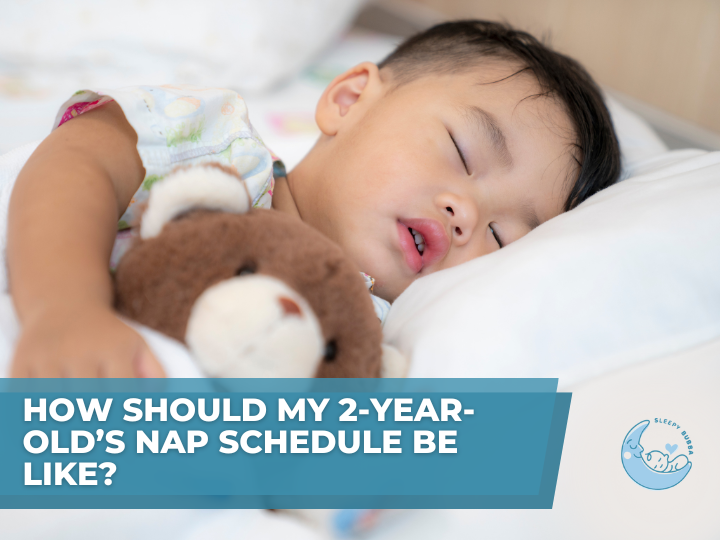Enquire Now with FREE 15 Mins Call
How Should My 2-Year-Old’s Nap Schedule Be Like?

As your little one progresses from infancy to toddlerhood, sleep remains a top priority. For most toddlers and preschoolers, an afternoon nap is a vital part of their daily routine. Are you navigating the evolving sleep needs of your growing toddler? Understanding the nap schedule for a 2-year-old can be crucial for a well-rested child and a harmonious household. Parents often seek guidance from toddler sleep consultant Singapore about wake windows, nap schedules, and more for their little ones. In this article, we’ll explore typical sleep patterns, signs of readiness to transition, and effective strategies for a smooth naptime routine.
When Do Toddlers Stop Napping?
Most toddlers will naturally outgrow napping between the ages of 3 and 4. Research indicates that less than 2.5% of toddlers stop napping before the age of 2, while a whopping 94% stop naps by age 5. While maintaining a nap is generally beneficial until around 4 years old, certain signs may suggest it’s time to consider dropping the nap if it impacts nighttime sleep negatively. Assess your toddler’s bedtime routine and nighttime sleep patterns for cues.
Should I Wake My Toddler From a Nap?
Yes, if your toddler’s nap extends too long, it might interfere with bedtime sleep. Toddlers typically need 12-14 hours of total sleep in 24 hours, including naps. Waking your toddler from a nap ensures they remain appropriately tired for bedtime, contributing to a more restful night.
Sleep Schedule Guidelines
While each child is unique, providing a flexible routine can aid in setting a suitable schedule. A 2-year-old typically requires 1-3 hours of daytime sleep, bedtime between 7:00-8:00 pm. Introduce age-appropriate activities, ensuring a balance of independent play and interactive engagement.
How Much Sleep Does a 2-Year-Old Need?
A 2-year-old generally needs around 12-14 hours of total sleep in 24 hours, with most thriving at the higher end of this range.
How Long Do 2-Year-Olds Nap?
A 2-year-old benefits from a nap duration of 1-3 hours, contributing to the recommended 10-12 hours of nighttime sleep.
Ideal Bedtime
For optimal sleep, most toddlers, preschoolers, and young children thrive with a bedtime between 7:00 and 8:00 pm. Studies emphasize the benefits of an early bedtime, promoting better sleep quality and improved behavioral outcomes.
Engaging Activities
Engage your 2-year-old in activities that stimulate creativity and motor skills. Options include engaging in building blocks with your toddler and fostering fine motor skills and teamwork. Host a “freeze” dance party! Play music for 10-15 seconds, then pause it and shout “Freeze!” Demonstrate until your toddler catches on and joins in. Read your preferred toddler books together, encouraging language development by prompting your toddler to point to various objects. Encourage independent play, problem-solving skills, and hand-eye coordination with puzzles.
When Should I Transit Nap to Quiet Time?
The perfect time to introduce quiet time for your toddler, instead of a nap, is when you notice signs of readiness. If your little one is taking longer to fall asleep at bedtime, resisting naps, waking up too early, or having difficulty staying asleep during the night, these could be indicators. Observing these signs consistently over about 5 days or most days in the past 2 weeks suggests your toddler might be ready for the transition. This shift can provide a restorative break, allowing your child to choose between rest or independent play, fostering creativity, and problem-solving skills, and giving parents a much-needed break.
How Do I Transition From Nap to Quiet Time?
1. Start Small
Initiate the transition with short periods, gradually extending as your toddler adapts. For instance, starting with 10-15 minutes and gradually increasing by 15 minutes every few days depending on how your baby is adjusting. Our objective is to achieve 60-90 minutes of quiet time without needing any form of help.
2. Consistent Bedtime Routine
Establishing a predictable bedtime routine such as reading a bedtime story to signal the onset of quiet time.
3. Signs of Readiness
Transition to quiet time when signs indicate readiness. If your toddler takes more than 30 minutes to fall asleep at nap or bedtime, exhibits resistance to napping, experiences early morning awakenings like before 6:00 am, or engages in content play during designated sleep times, it may be time for quiet time. Look for consistent signs indicating your toddler is ready for a change in sleep routine.
4. Room Setup
Create a safe and calm environment for quiet time, ensuring childproofing measures such as enhancing safety with a door alarm to notify you if your toddler exits the room. Safely anchor tall furniture to the wall and adjust reachable decorations. Use a video monitor to observe your toddler during quiet time. Cover electrical outlets and eliminate loose cords or wires.
5. Provide Choices
Offer options for independent play during quiet time, encouraging creativity and engagement. Most toddlers thrive with 3-5 activity options. Keep a fixed list of activities exclusively for quiet time, rotating them every few weeks to maintain interest. When selecting activities, opt for calm and quiet options, prioritizing safety by avoiding choking hazards or activities needing supervision. Consider items like toy animals, blocks, or puzzles to engage your toddlers.
6. Consistency is key
Maintain consistency during the transition from nap time to quiet time. Even with the right tools, this change can be significant. While some toddlers adapt swiftly, others may take 2-4 weeks. Reinforce the message that quiet time is non-negotiable. Expect some days to be successful and others challenging during this transition. Patience and steadfast consistency will help you reach your goal!
7. Celebrate Success
Acknowledge and celebrate your child’s achievements during quiet time, fostering a positive association.
Conclusion

In short, understanding and navigating the evolving nap schedule of a 2-year-old is pivotal for fostering a well-rested and contented child. As parents, recognizing the signs of readiness to transition from napping to quiet time empowers us to create a sleep routine tailored to our child’s individual needs. Whether it’s maintaining a nap schedule, making adjustments, or embracing the transition to quiet time, the key lies in consistency, patience, and celebrating the small wins along the way. Remember, every child is unique, and what works best for one may differ for another. At Sleepy Bubba, our dedicated toddler sleep consultant Singapore is here to support you every step of the way. With expert guidance on toddler sleep training Singapore, you can ensure your toddler receives the restorative sleep they require for optimal growth and development. Why wait? Don’t hesitate to schedule a FREE 20-minute discovery call with us. Here’s to peaceful nights and happy days for both you and your little one!







